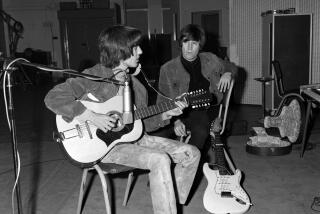Why They’re Music to Fans’ Ears
I got my Martin in 1963. I actually got two that year, but the first, a little OO-18, had to go to help bankroll the D-18 I found hanging on the wall at McCabe’s Guitar Shop in Santa Monica.
The affordable price--$240--was due in part to a bad stain job on the top soundboard, but that didn’t really matter to a high school baby boomer and hard-core folkie. The instrument had that tonal balance that Martin boosters rhapsodize about. It was a huge, squarish box of sound, an actual D model--D for “Dreadnought,” named for the British battleship. It might have been cosmetically incorrect, but it looked like it had done some hard traveling. The one Doc Watson held on the cover of his first album looked a little beat up too.
That 1954 guitar still serves the living-room picker well, but a dip into Jim Washburn and Richard Johnston’s “Martin Guitars: An Illustrated Celebration of America’s Premier Guitarmaker” (Rodale Press) can make the owner of a measly single instrument feel a little inadequate.
Take the Martin collectors. Mac Yasuda has 250, including 14 of the 75 or 80 prewar D-45s presumed to still exist. Of Scott Chinery’s 1,000 guitars, about 100 are Martins. These gentlemen are described, somewhat vaguely, as “successful in business.” Somewhere closer to earth is fixed-income retiree Travis Harrelson, most of whose 60 Martins are . . . ukuleles.
These anecdotal sidebars--ranging from explanations of Martin’s revolutionary X-bracing system to mini-biographies of such Martin players as Jimmie Rodgers, Stephen Stills and Willie Nelson--are woven throughout the book, brightening the straightforward narrative history of C.F. Martin & Co. that serves as its backbone.
The firm was established in New York in 1833 by Carl Frederick Martin (Martin owners know that year well--it’s inscribed under the maker’s name on his products’ pegheads). Martin, an immigrant from Saxony, relocated to Nazareth, Pa., some six years later, and the family-owned enterprise would eventually set the standard for the popular acoustic guitar. Though Gibson and others have their partisans, it’s Martins that are part of the enduring images of everyone from Gene Autry to Elvis Presley, Hank Williams to Crosby, Stills & Nash.
“Martin Guitars” doesn’t spare the details in telling the story, which doesn’t always zip along dramatically. The family’s conservative, slow-growth philosophy sometimes seems annoyingly stodgy. But it’s all here, for better and worse, and Washburn and Johnston help it along with a touch of irreverence and attitude.
When the story lags, you can always take a break and bask in the multitude of vivid photos of guitars, including rarities and oddities, or study the minutiae of the instruments’ design and decoration.
It works as casual read and compact reference resource, but ultimately, inevitably, this book demands that you set it down and pop open your guitar case.
More to Read
The biggest entertainment stories
Get our big stories about Hollywood, film, television, music, arts, culture and more right in your inbox as soon as they publish.
You may occasionally receive promotional content from the Los Angeles Times.










